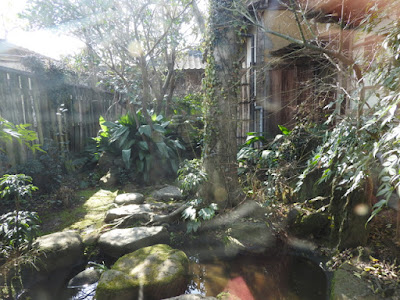目次
/
Contents
1) 世界遺産 /
World Heritage
2)
散策
/
Walking
3) カフェ : 'コトコト' / Cafe : 'cotocoto'
3) カフェ : 'コトコト' / Cafe : 'cotocoto'
1) 世界遺産 / World Heritage
3) 大板山たたら製鉄遺跡 : ★ / ★
私達のツアーでは、3)を除く、4箇所に行きました。
'Sites of Japan’s Meiji Industrial Revolution: Iron and Steel, Shipbuilding and Coal Mining' was registered as World Heritage listing in 2015 and they are dotted over 8 Prefectures : Yamaguchi, Fukuoka, Saga, Nagasaki, Kumamoto, Kagoshima, Iwate and Shizuoka.
Japanese Meiji Industrial Revolution : ★ in English.
In Yamaguchi, there are 5 sites : Hagi Proto-industrial Heritage, below.
1) Hagi Reverbatory Furnace : ★
2) Ebisugahana Shipyard : ★
3) Ohitayama Tatara Iron Works : ★
4) Hagi Castle Town : ★
5) Shōkasonjuku Academy : ★
We went to 4 sites, but not 3) Ohitayama Tatara Iron Works in our tour.
After Shōkasonjuku Academy, we visited Hagi Castle Town, although the area was different from 'Kitamon - Yashiki' which we stayed last night.
'Kitamon - Yashiki' is close to the Hagi Castle, a former high-ranking Bushi residence area in the Castle Town even though at the same Town, here was like a former lower-ranking Bushi residence area : Edoya Street and Kikuya Street.
2) 散策 / Walking
 |
| 萩城下町 : ★ / ★ 江戸家横丁と菊屋横丁界隈 碁盤の目の作りになっています。 Hagi Castle Town : ★ The vicinity of Edoya-yokochou Street and Kikuya-yokocho Street The layout of the town is like a Go board : Checkerboard. |
ここで許された時間は1時間で、20~30分は、バスガイドさんの後に続いて歩きました。
ここに載せる街並みの写真の殆どは、そのときに撮影したものです。
自由時間は、約30分ほど。
朝食で、コーヒーが飲めなかったRがコーヒーを欲して、自由時間はカフェタイムでした。
なので、ここでは殆ど散策ができず、公開されている家も入ることはできず、白壁が美しく、萩焼のお店が複数あると聞く菊屋横丁も全く見られませんでした。
ただ、ラッキーなことに、利用したカフェは、とても素敵な雰囲気がある、築200年の家でした。
少ない時間で走り回るように、あちこち見るよりは、そのカフェで比較的落ちついて、一杯カフェオレを飲む時間の方が、私達にはあっています。
この旅では、早足で見て歩くことが多く、精神的に少しまいってきていましたので、結果からいえば、良かったのです。
 |
|
helped their economy. So Yamagauchi Prefecture has many Natsumikan and their processed products. |
We could only have an hour here, although we should walk and follow our bus guide for about 20~30 minutes.
I show most photographs of the street in this section which I photographed at this time.
We only had about 30 minutes free time .
R could not have coffee with breakfast, he desired coffee so we used our time as cafe time.
Therefore we could not mostly walk around the Town, could not go into houses which are open to the public and I heard the white walls are beautiful and that there are a few Hagi-ceramics shops on the Kikuya-yokocho Street, which we could not see at all.
However, we were lucky that the cafe we used has a lovely atmosphere and is a 200 years old house.
It suited us that we had a cup of café au lait relatively calmly in the cafe rather than we walked fast and looked here and there.
In this trip, often while we walked quickly and looked at some things my mind became tired, so our choice was good.
 |
| こういう感じを城下町には期待しますよね? Do we expect things like these in a Castle Town?  |
 |
| 円政寺 (エンセイジ) :★ 通り過ぎただけです。 Enseiji Temple We just walked in front of the temple. |
 |
| 木戸孝允 (桂小五郎) 旧宅 木戸孝允 (キドタカヨシ / 1833 - 1877) 旧宅の屋内は見学できますが、 私達にはその時間はありませんでした。 Takayoshi Kido (1833 -1877) Residence You can go inside, although we did not have time for it. |
 |
| 夏みかんがたくさん。 Many Natsumikan |
 |
| 散策の殆どは、バスガイドさん一緒で、この江戸家横丁の通り。 Most of our walking was in this street ; Edoya-yokocho street with the bus guide. |
 |
| 御成道 この道でフリータイム。 Onarimichi : Onari Street We became free on this street.  |
 |
| 菊屋家住宅 時間があったら入ってみたかったけれど.... Kikura Residence If I had time I would go in...  |
3) カフェ : コトコト / Cafe : cotocoto
 |
| 御成道沿いにあります。 The cafe is on Onari Street. |
 |
| 雑貨や衣類のお店にもなっています。 そうそう、靴を脱ぐのです。 They sell things and clothes. Oh! Yes! We must take our shoes off.   |
 |
| お店のおくにカフェ、'コトコト'があります。 Behind the shop is the Cafe : 'cotocoto'.   |
 |
| まったりカフェ風 / Very Relaxing Cafe style |
 |
| 良い感じでしょう? 庭に面する席を選びました。 Here has a good atmosphere, doesn't it? We selected our table beside the garden. |
 |
| 庭があるのとないのとでは格段に違う! With a garden is very different from without a garden, isn't it?  |
 |
| おいてあった、萩の写真週もおしゃれでした。 朝食をあまり食べなかったRは、ここで軽食もとりました。 私は飲み物だけ。 They have a photograph book of Hagi which is stylish. R did not have enough breakfast and he had a snack here as well. I just had a drink. |
さあ!時間です! / Come on! Time's Up!
 |
| 伊勢屋横丁 伊勢屋横丁を早歩きしつつ撮影。 バスガイドさんに「ここは何もありません」と言われましたが、 菊屋横丁まで回る時間がなかったのでした〜〜! Iseya-yokosho Street While I walked quickly on Iseya-yokosho Street, I photographed this. Although the bus guide said 'this street does not have anything', we did not have time for Kikuya-yokocho which was further away than this street. |
 |
高杉晋作像
2010年建立
高杉晋作 (1839
-1867) の家には行けなかったので、
せめて銅像だけと思って撮影。
萩城を向いて、'晋作広場'に立っています。
晋作は28歳の若さで亡くなっていますが病死です。
師である吉田松陰 (1830
-1859) 自身も29歳で亡くなっています。
晋作含め、彼の教え子の多くは若くして命をおとしています。
太く短く生きたという印象を受けます。
他52名の塾生達と一緒に祀られています。→★
晋作も松門神社では、神様なんです。
日本は今、昔からの八百万の神々よりも
人から神になった神々 : 人神が多いのではないでしょうか?
Takasugi Shinsaku Statue
It
was built in 2010.
I
could not go the Old Residence of Takasugi
Shinsaku (1839
-1867),
so
I thought at least I should photograph the Statue.
He
looks towards the Hagi
Castle and
stands in the 'Shinsaku Square'.
He
passed away very young, at 28 years old, but he died of illness.
His
master, Yoshida Shōin (1830
-1859) was killed at 29 years old.
Moreover,
most of the master's students including Shinsaku died
when
they were young.
My
impression is that they lived shortly and deeply.
Shinsaku with
his 52 fellows are deified to
Shoumon
Shrine next to Shouin Shrine. →★
Now Shinsaku is
one of Gods!
Is
it that nowadays in Japan more people become Gods than
the
original Gods, Yaoyorozu
no kamigami ? |






















